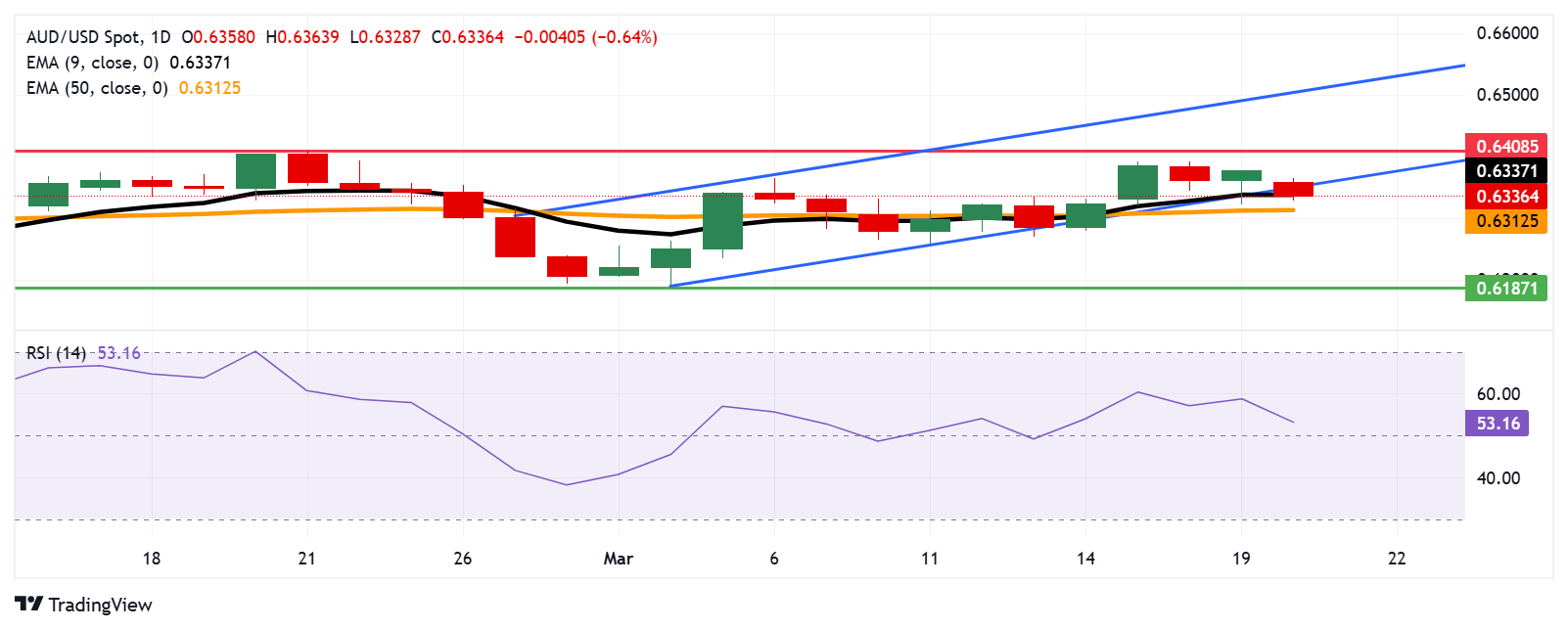Spread dan syarat terbaik kami
 Ketahui selanjutnya
Ketahui selanjutnya
The Australian Dollar (AUD) weakens against the US Dollar (USD) on Thursday, reversing gains from the previous session. The AUD/USD pair declines as the AUD receives downward pressure following the release of domestic employment data.
Australia’s Employment Change dropped by 52.8K in February against the 30.5K increase in January (revised from 44K), falling short of the consensus forecast of 30.0K rise. Meanwhile, the seasonally adjusted Unemployment Rate remained steady at 4.1% in February, aligning with market expectations.
In China, the People’s Bank of China (PBOC) kept its Loan Prime Rates (LPRs) unchanged on Thursday, with the one-year rate at 3.10% and the five-year rate at 3.60%.
The Federal Reserve maintained the federal funds rate at 4.25%–4.5% in its March meeting, as widely expected. The Fed reaffirmed its outlook for two rate cuts later this year but cited uncertainty stemming from US President Donald Trump’s tariff policies.
AUD/USD is trading near 0.6330 on Thursday, with technical analysis suggesting a weakening bullish bias as the pair breaks below the ascending channel pattern. However, the 14-day Relative Strength Index (RSI) remains above 50, indicating that bullish momentum is still in play.
The pair may attempt to surpass the immediate resistance at the nine-day Exponential Moving Average (EMA) of 0.6337, which aligns with the lower boundary of the ascending channel. A return to the channel could reinforce the bullish outlook, potentially leading AUD/USD to retest its three-month high of 0.6408, last reached on February 21. Further resistance is seen at the upper boundary of the channel near 0.6490.
On the downside, immediate support lies at the 50-day EMA at 0.6312. A decisive break below this key level could weaken the medium-term price momentum, exposing the AUD/USD pair to further downside pressure toward the six-week low of 0.6187, recorded on March 5.

The table below shows the percentage change of Australian Dollar (AUD) against listed major currencies today. Australian Dollar was the weakest against the Japanese Yen.
| USD | EUR | GBP | JPY | CAD | AUD | NZD | CHF | |
|---|---|---|---|---|---|---|---|---|
| USD | -0.05% | -0.01% | -0.30% | 0.02% | 0.32% | 0.36% | -0.15% | |
| EUR | 0.05% | 0.03% | -0.23% | 0.06% | 0.36% | 0.41% | -0.10% | |
| GBP | 0.00% | -0.03% | -0.25% | 0.02% | 0.33% | 0.38% | -0.13% | |
| JPY | 0.30% | 0.23% | 0.25% | 0.30% | 0.59% | 0.62% | 0.21% | |
| CAD | -0.02% | -0.06% | -0.02% | -0.30% | 0.31% | 0.35% | -0.17% | |
| AUD | -0.32% | -0.36% | -0.33% | -0.59% | -0.31% | 0.05% | -0.46% | |
| NZD | -0.36% | -0.41% | -0.38% | -0.62% | -0.35% | -0.05% | -0.54% | |
| CHF | 0.15% | 0.10% | 0.13% | -0.21% | 0.17% | 0.46% | 0.54% |
The heat map shows percentage changes of major currencies against each other. The base currency is picked from the left column, while the quote currency is picked from the top row. For example, if you pick the Australian Dollar from the left column and move along the horizontal line to the US Dollar, the percentage change displayed in the box will represent AUD (base)/USD (quote).
The Employment Change released by the Australian Bureau of Statistics is a measure of the change in the number of employed people in Australia. The statistic is adjusted to remove the influence of seasonal trends. Generally speaking, a rise in Employment Change has positive implications for consumer spending, stimulates economic growth, and is bullish for the Australian Dollar (AUD). A low reading, on the other hand, is seen as bearish.
Read more.Last release: Thu Mar 20, 2025 00:30
Frequency: Monthly
Actual: -52.8K
Consensus: 30K
Previous: 44K
Source: Australian Bureau of Statistics